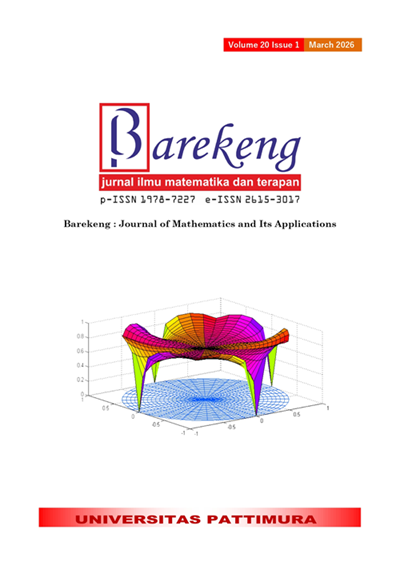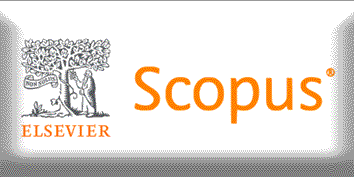COMPARISON OF BINARY PROBIT REGRESSION AND FOURIER SERIES NONPARAMETRIC LOGISTIC REGRESSION IN MODELING DIABETES STATUS AT HAJJ GENERAL HOSPITAL SURABAYA
Abstract
Diabetes mellitus is a chronic disease with a rising global prevalence, including in Indonesia. Early detection and accurate modeling are crucial for effective prevention and management. Binary Logistic Regression (BLR) is commonly used for binary outcome modeling; however, in practice, the relationship between binary outcomes and continuous predictors is often nonlinear, making BLR less suitable. To address these limitations, alternative methods such as Binary Probit Regression (BPR) and Flexible Semiparametric Nonlinear Binary Logistic Regression (FSNBLR) have been developed. This study aims to compare the performance of BLR, BPR, and FSNBLR models in classifying diabetes mellitus cases at Hajj General Hospital Surabaya. All three models were estimated using the Maximum Likelihood Estimation (MLE) method. Since the resulting estimators do not have closed-form solutions, numerical iteration using the Newton-Raphson method was applied. Model performance was assessed using Area Under the Curve (AUC), accuracy, sensitivity, and specificity. The FSNBLR model outperformed both the BLR and BPR models. It achieved the highest AUC value of 81.86%, while BLR (66.30%) and BPR (66.30%). That is indicated FSNBLR superior discriminative ability. In addition, the FSNBLR model recorded higher accuracy, sensitivity, and specificity compared to the other two models. The FSNBLR model demonstrated better predictive performance in identifying diabetes mellitus cases, especially in scenarios involving nonlinear relationships between predictors and the outcome variable. These findings suggest that flexible semiparametric approaches offer greater effectiveness in medical classification tasks, particularly for chronic conditions like diabetes mellitus.
Downloads
References
F.E. Harrell Jr., REGRESSION MODELING STRATEGIES: WITH APPLICATIONS TO LINEAR MODELS, LOGISTIC AND ORDINAL REGRESSION, AND SURVIVAL ANALYSIS, 2nd ed., Springer, 2015. doi: https://doi.org/10.1198/tech.2003.s158.
J.J. Faraway, EXTENDING THE LINEAR MODEL WITH R: GENERALIZED LINEAR, MIXED EFFECTS AND NONPARAMETRIC REGRESSION MODELS, 2nd ed., Chapman & Hall/CRC, 2016.doi: https://doi.org/10.1201/9781315382722
M. M. Panja and B. N. Mandal, WAVELET BASED APPROXIMATION SCHEMES FOR SINGULAR INTEGRAL EQUATIONS. 2020. doi: https://doi.org/10.4324/9780429244070.
Y. Farida, I. Purwanti, and N. Ulinnuha, “COMPARING GAUSSIAN AND EPANECHNIKOV KERNEL OF NONPARAMETRIC REGRESSION IN FORECASTING ISSI (INDONESIA SHARIA STOCK INDEX),” BAREKENG: Journal of Mathematics and Applications, vol. 16, no. 1, pp. 323-332, 2022. doi: https://doi.org/10.30598/barekengvol16iss1pp321-330.
B. Pratama, A. Suryono, N. Auliyah, and N. Chamidah, “COMPARISON OF LOCAL POLYNOMIAL REGRESSION AND ARIMA IN PREDICTING THE NUMBER OF FOREIGN TOURIST VISITS TO INDONESIA,” BAREKENG: Journal of Mathematics and Applications, vol. 18, no. 1, pp. 53-64, 2024.doi: https://doi.org/10.30598/barekengvol18iss1pp0043-0052
M.D. Cattaneo, M. Jansson, and X. Ma, “LOCAL REGRESSION DISTRIBUTION ESTIMATORS,” Journal of Econometrics, vol. 240, no. 2, p. 105074, 2024.doi: https://doi.org/10.1016/j.jeconom.2021.01.006
S.D.P. Yasmirullah, B.W. Otok, J.D.T. Purnomo, and D.D. Prastyo, “PARAMETER ESTIMATION OF MULTIVARIATE ADAPTIVE REGRESSION SPLINE (MARS) WITH STEPWISE APPROACH TO MULTI DRUG-RESISTANT TUBERCULOSIS (MDR-TB) MODELING IN LAMONGAN REGENCY,” Journal of Physics: Conference Series, vol. 1752, p. 012017, IOP Publishing, 2021.doi: https://doi.org/10.1088/1742-6596/1752/1/012017
S.D.P. Yasmirullah, B.W. Otok, J.D.T. Purnomo, and D.D. Prastyo, “MODIFICATION OF MULTIVARIATE ADAPTIVE REGRESSION SPLINE (MARS),” Journal of Physics: Conference Series, vol. 1863, p. 012017, IOP Publishing, 2021. doi: https://doi.org/10.1088/1742-6596/1863/1/012078.
P.A. Morettin and R.F. Porto, “ESTIMATION OF NONPARAMETRIC REGRESSION MODELS BY WAVELETS,” São Paulo Journal of Mathematical Sciences, vol. 16, pp. 539–565, 2022. doi: https://doi.org/10.1007/s40863-021-00240-5.
M.D. Pasarella, Sifriyani, and F.D.T. Amijaya, “NONPARAMETRIC REGRESSION MODEL ESTIMATION WITH THE FOURIER SERIES APPROACH AND ITS APPLICATION TO THE ACCUMULATIVE COVID-19 DATA IN INDONESIA,” BAREKENG: Journal of Mathematics and Its Application, vol. 16, no. 4, pp. 1167–1174, 2022. doi: https://doi.org/10.30598/barekengvol16iss4pp1167-1174.
B.B. Jena, S.K. Paikray, and M. Mursaleen, “ON THE DEGREE OF APPROXIMATION OF FOURIER SERIES BASED ON A CERTAIN CLASS OF PRODUCT DEFERRED SUMMABILITY MEANS,” Journal of Inequalities and Applications, vol. 2023, no. 18, 2023. doi: https://doi.org/10.1186/s13660-023-02927-z.
D.S. Sheiso, “APPROXIMATION OF FUNCTIONS USING FOURIER SERIES AND ITS APPLICATION TO THE SOLUTION OF PARTIAL DIFFERENTIAL EQUATIONS,” Science Journal of Applied Mathematics and Statistics, vol. 10, no. 4, pp. 57-84, 2022. doi: https://doi.org/10.2139/ssrn.4775015.
W. Gazali, “THE ORIGIN OF THE BASIC FORMULA OF THE FOURIER SERIES,” Engineering, Mathematics and Computer Science Journal (EMACS), vol. 5, no. 1, 2023. doi: https://doi.org/10.21512/emacsjournal.v5i1.9398.
M.L. Maslakov and V.V. Egorov, “FOR THE PROBLEM OF PHASE PROBABILITY DENSITY FUNCTION ESTIMATION,” Numerical Analysis and Applications, vol. 15, no. 2, pp. 125–137, 2022. doi: https://doi.org/10.15372/SJNM20220205.
Kuzairi, Miswanto, and M.F.F. Mardianto, “SEMIPARAMETRIC REGRESSION BASED ON FOURIER SERIES FOR LONGITUDINAL DATA WITH WEIGHTED LEAST SQUARE (WLS) OPTIMIZATION,” Journal of Physics: Conference Series, vol. 1836, no. 1, 2021. doi: https://doi.org/10.1088/1742-6596/1836/1/012038.
H. Husain, I. N. Budiantara, and I. Zain, “MIXED ESTIMATOR OF SPLINE TRUNCATED, FOURIER SERIES, AND KERNEL IN BIRESPONSE SEMIPARAMETRIC REGRESSION MODEL,” IOP Conf. Ser. Earth Environ. Sci., vol. 880, no. 1, 2021, doi: https://doi.org/10.1088/1755-1315/880/1/012046.
I. Wayan Sudiarsa, I. Nyoman Budiantara, S. Suhartono, and S. W. Purnami, “COMBINED ESTIMATOR FOURIER SERIES AND SPLINE TRUNCATED IN MULTIVARIABLE NONPARAMETRIC REGRESSION,” Appl. Math. Sci., vol. 9, no. 97–100, pp. 4997–5010, 2015, doi: https://doi.org/10.12988/ams.2015.55394.
N. P. A. M. Mariati, I. N. Budiantara, and V. Ratnasari, “COMBINATION ESTIMATION OF SMOOTHING SPLINE AND FOURIER SERIES IN NONPARAMETRIC REGRESSION,” J. Math., vol. 2020, 2020, doi: https://doi.org/10.1155/2020/4712531.
I.N. Budiantara, V. Ratnasari, M. Ratna, W. Wibowo, N. Afifah, D.P. Rahmawati, and M.A.D. Octavanny, “MODELING PERCENTAGE OF POOR PEOPLE IN INDONESIA USING KERNEL AND FOURIER SERIES MIXED ESTIMATOR IN NONPARAMETRIC REGRESSION,” Investigacion Operacional, vol. 40, pp. 538-551, 2019.
K. Nisa, I.N. Budiantara, and A.T. Rumiati, “MULTIVARIABLE SEMIPARAMETRIC REGRESSION MODEL WITH COMBINED ESTIMATOR OF FOURIER SERIES AND KERNEL,” in IOP Conference Series: Earth and Environmental Science, pp. 012028, IOP Publishing, 2017.doi: https://doi.org/10.1088/1755-1315/58/1/012028
A.T. Ampa, I.N. Budiantara, and I. Zain, “MODELING THE LEVEL OF DRINKING WATER CLARITY IN SURABAYA CITY DRINKING WATER REGIONAL COMPANY USING COMBINED ESTIMATION OF MULTIVARIABLE FOURIER SERIES AND KERNEL,” Sustainability, vol. 14, pp. 13663, 2022. doi: https://doi.org/10.3390/su142013663.
M. Ramli, I.N. Budiantara, and V. Ratnasari, “A METHOD FOR PARAMETER HYPOTHESIS TESTING IN NONPARAMETRIC REGRESSION WITH FOURIER SERIES APPROACH,” MethodsX, vol. 11, p. 102468, 2023. doi: https://doi.org/10.1016/j.mex.2023.102468.
P.H. Jou and S.H. Mirhashemi, “FREQUENCY ANALYSIS OF EXTREME DAILY RAINFALL OVER AN ARID ZONE OF IRAN USING FOURIER SERIES METHOD,” Applied Water Science, vol. 13, p. 16, 2023. doi: https://doi.org/10.1007/s13201-022-01823-z.
L. Laome, I.N. Budiantara, and V. Ratnasari, “POVERTY MODELING WITH SPLINE TRUNCATED, FOURIER SERIES, AND MIXED ESTIMATOR GEOGRAPHICALLY WEIGHTED NONPARAMETRIC REGRESSION,” in AIP Conference Proceedings, AIP Publishing, 2024. doi: https://doi.org/10.1063/5.0206173.
S. Suliyanto, M. Rifada, and E. Tjahjono, “ESTIMATION OF NONPARAMETRIC BINARY LOGISTIC REGRESSION MODEL WITH LOCAL LIKELIHOOD LOGIT ESTIMATION METHOD (CASE STUDY OF DIABETES MELLITUS PATIENTS AT SURABAYA HAJJ GENERAL HOSPITAL),” in Symposium on Biomathematics 2019, pp. 1551-7616, AIP Conference Proceedings, Bali, 2020. doi: https://doi.org/10.1063/5.0025807.
H. Hamie, A. Hoayek, B. El-Ghoul, and M. Khalifeh, “APPLICATION OF NON-PARAMETRIC STATISTICAL METHODS TO PREDICT PUMPABILITY OF GEOPOLYMERS FOR WELL CEMENTING,” Journal of Petroleum Science and Engineering, vol. 212, p. 110333, 2022. doi: https://doi.org/10.1016/j.petrol.2022.110333.
T. Wang, W. Tang, Y. Lin, and W. Su, “SEMI-SUPERVISED INFERENCE FOR NONPARAMETRIC LOGISTIC REGRESSION,” Statistics in Medicine, vol. 42, pp. 2573–2589, 2023. doi: https://doi.org/10.1002/sim.9737.
M. Zulfadhli, I.N. Budiantara, and V. Ratnasari, “NONPARAMETRIC REGRESSION ESTIMATOR OF MULTIVARIABLE FOURIER SERIES FOR CATEGORICAL DATA,” MethodsX, p. 102983, 2024. doi: https://doi.org/10.1016/j.mex.2024.102983.
V. Ratnasari, S. H. Utama, and A. T. R. Dani, “TOWARD SUSTAINABLE DEVELOPMENT GOALS (SDGS) WITH STATISTICAL MODELING: RECURSIVE BIVARIATE BINARY PROBIT,” IAENG Int. J. Appl. Math., vol. 54, no. 8, pp. 1515–1521, 2024.
Copyright (c) 2025 Bambang Widjanarko Otok, Muhammad Zulfadhli, Riwi Dyah Pangesti, Muhammad Idham Kurniawan, Albertus Eka Putra Haryanto, Darwis Darwis, Iwan Kurniawan

This work is licensed under a Creative Commons Attribution-ShareAlike 4.0 International License.
Authors who publish with this Journal agree to the following terms:
- Author retain copyright and grant the journal right of first publication with the work simultaneously licensed under a creative commons attribution license that allow others to share the work within an acknowledgement of the work’s authorship and initial publication of this journal.
- Authors are able to enter into separate, additional contractual arrangement for the non-exclusive distribution of the journal’s published version of the work (e.g. acknowledgement of its initial publication in this journal).
- Authors are permitted and encouraged to post their work online (e.g. in institutional repositories or on their websites) prior to and during the submission process, as it can lead to productive exchanges, as well as earlier and greater citation of published works.






1.gif)



